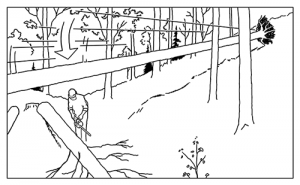BACKGROUND: On a windy, fall afternoon in the Appalachians, a logger was felling and bucking timber.
PERSONAL CHARACTERISTICS: The 56-year-old logging business owner had been a logger for many years. He was experienced and “fully trained,” and he was wearing personal protective equipment, including a hard hat.
UNSAFE ACT AND CONDITIONS: The logger apparently failed to notice that there was a large, dead tree in the area where he was cutting and bucking timber. There were strong wind gusts on the afternoon of the incident. He was using his chain saw to trim limbs off a felled white pine tree that was close to the dead tree.
ACCIDENT: The dead tree fell or blew over, pulling its roots out of the ground and striking the logger’s head.
INJURY: The hard hat was not enough to protect the logger. (The tree trunk was about 18 inches in diameter at the point where it hit the logger.) When the skidder operator returned from the log deck to the area where the logger was working, he found the logger, already dead.
RECOMMENDATIONS FOR CORRECTION: Do not manually fell and trim timber during periods of high winds. Always look up and around the immediate working area to identify hazards before beginning felling operations.
OSHA logging regulations specify that “each danger tree, including lodged trees and snags, shall be felled or removed using mechanical or other techniques that minimize employee exposure before work is commenced in the area of the danger tree. If the danger tree is not felled or removed, it shall be marked and no work shall be conducted within two tree lengths of the danger tree unless the employer demonstrates that a shorter distance will not create a hazard for an employee.”
Courtesy of the Forest Resources Association: https://www.forestresources.org/page.asp?content=startpage&g=FRA

